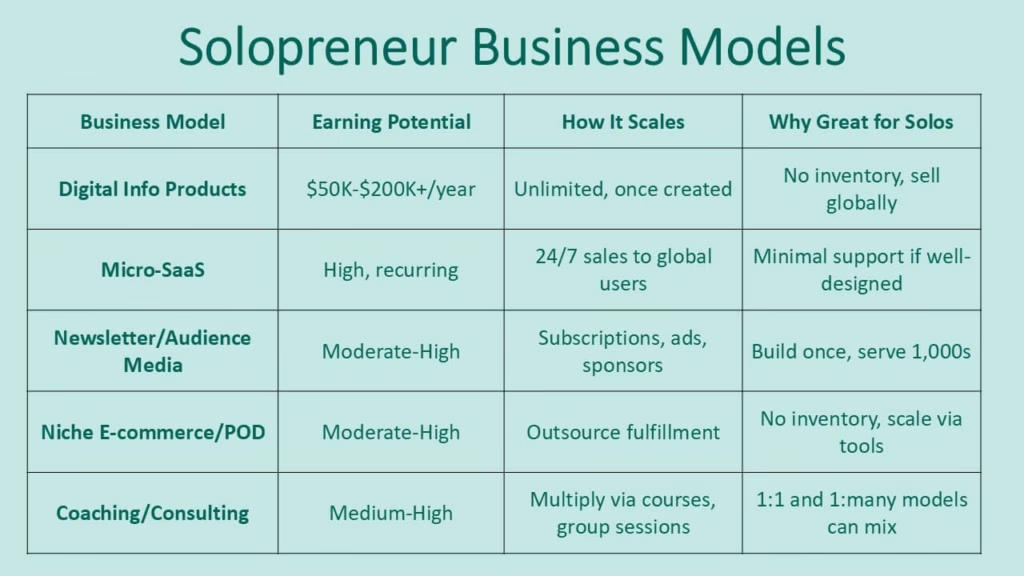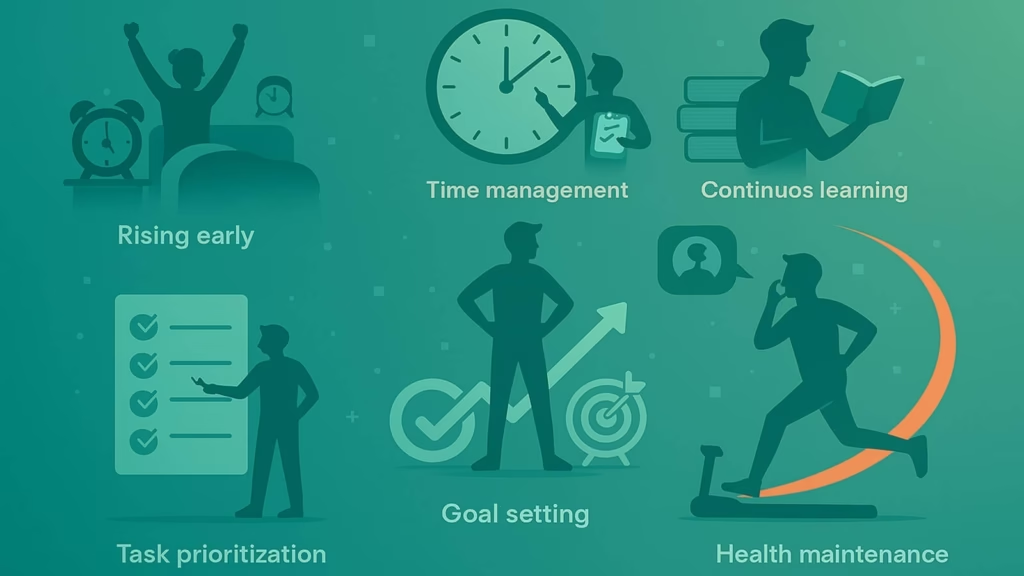The year 2025 represents a golden age for solopreneurs—individuals building highly profitable, scalable businesses single-handedly. Technology, automation, and the global digital economy have converged to create unprecedented opportunities for one-person empires that generate six and seven-figure revenues without traditional employees, offices, or massive overhead costs. These modern entrepreneurs are redefining what it means to “build big” by proving that ambition, not headcount, drives true scale in the digital age—a fact demonstrated by the rise of compelling solopreneur profiles across the globe.
Defining the Solopreneur Revolution
A solopreneur is an entrepreneur who single-handedly runs and manages their entire business operation. Unlike traditional entrepreneurs who scale by hiring teams, solopreneurs leverage technology, automation, and strategic systems to build “companies of one” that can compete with much larger organizations. The solopreneur movement has exploded globally, with over 50 million digital nomads worldwide in 2025, many of whom operate as location-independent solopreneurs.
The statistics are compelling: 82% of all U.S. businesses are run by solopreneurs, and the number of American solopreneurs has grown by 147% since 2019. This isn’t just a trend—it’s a fundamental shift in how business gets done. Modern solopreneurs are building sustainable, profitable ventures that often outperform traditional small businesses in terms of profit margins and lifestyle freedom.
Busting the “Big Team” Myth
The conventional wisdom that “you need a big team to hit big profits” is being shattered by solopreneurs who consistently demonstrate that lean operations can be incredibly lucrative. Paul Jarvis, author of “Company of One” and co-founder of Fathom Analytics, built a multimillion-dollar ecosystem through courses, books, and his privacy-focused analytics SaaS—all while maintaining a deliberately small operation focused on simplicity and automation. His philosophy proved that staying small can be the next big thing for business.
What Defines a Solopreneur Empire?

The Company of One Model
A solopreneur empire represents a business run and owned by a single person who may outsource specific tasks or work with contractors but maintains no full-time employees. This model offers distinct advantages: complete control over business decisions, maximum flexibility to pivot quickly, unprecedented speed in decision-making, and ultra-lean overhead that maximizes profit margins.
Successful solopreneur empires typically operate in digital-first markets where technology can amplify individual capabilities. They focus on scalable business models that can generate revenue without proportional increases in workload—the holy grail of entrepreneurial efficiency.
Key Characteristics of Solopreneur Success
The most successful solopreneurs share common characteristics that distinguish them from traditional entrepreneurs. They target specialized niches instead of broader markets, allowing them to become recognized experts in specific areas. They create personal brands that blend seamlessly with their business identity, making themselves the differentiating factor in competitive markets.
Perhaps most importantly, they set up systems that generate revenue even when they’re not actively working—the foundation of true scalability. They push business growth through automation and multiple income streams rather than hiring additional personnel, and they maintain complete independence in decision-making without the complexity of partner dynamics.
Typical Solopreneur Models in 2025
The digital economy has created numerous viable pathways for solopreneur success. Information products remain hugely popular, including online courses, ebooks, templates, and digital frameworks that can be created once and sold indefinitely. Micro-SaaS products are thriving as solopreneurs develop niche software solutions that solve specific problems for targeted audiences.
Content and media businesses, particularly newsletters and audience-building ventures, offer sustainable recurring revenue through subscriptions, advertising, and sponsorships. Niche e-commerce and print-on-demand operations allow solopreneurs to sell physical products without inventory management. Finally, coaching and consulting services provide high-margin opportunities that can evolve from one-on-one to one-on-many delivery models.

Solopreneur Business Models That Work Best “Solo” in 2025
Inspiring Solopreneur Profiles and Case Studies

Paul Jarvis: The Simplicity Pioneer (Canada)
Paul Jarvis exemplifies the power of intentional business design. Rather than scaling for scale’s sake, Jarvis built a six-figure ecosystem around his core philosophy of staying deliberately small. His business included bestselling books like “Company of One,” premium online courses, and Fathom Analytics—a privacy-focused Google Analytics alternative that he co-founded and eventually sold.
Jarvis’s approach centered on serving a specific niche exceptionally well rather than trying to be everything to everyone. He leveraged automation extensively to handle routine tasks, allowing him to focus on high-value activities like product development and strategic thinking. His success demonstrates that profit margins, not team size, determine business success.
Key Growth Strategy: Jarvis focused on building trust through transparency, sharing his business journey publicly, and creating products that solved real problems for his audience. He proved that a solopreneur could build a sustainable business by prioritizing customer value over rapid expansion.
Ankur Warikoo: The Education Empire Builder (India)
Ankur Warikoo represents the modern Indian solopreneur success story, having grown from a traditional entrepreneur to a content creator with over 14.8 million followers across platforms. His business, structured around WebVeda (his education startup), Brand Warikoo (personal brand and content), and multiple revenue streams, generated ₹16.84 crore (approximately $2 million) in 2024.
Warikoo’s journey began when COVID-19 disrupted his traditional speaking business, forcing him to pivot to online content creation. He started with a “pay what you want” webinar model using Razorpay, charging as little as ₹1 for attendance. This innovative approach allowed him to build an audience while testing market demand for his educational content.
Revenue Breakdown: Speaking engagements (₹2.38 crore), book royalties (₹1.65 crore), brand collaborations (₹2.76 crore), and WebVeda educational platform (₹9.56 crore). His transparent approach to sharing business metrics has made him a trusted figure in the Indian entrepreneurship space.
Key Success Factor: Warikoo’s authentic personal brand and commitment to education-first content creation. He focuses on helping people make decisions from awareness rather than ignorance, building trust through value-driven content before monetization.
Steph Smith: The Data-Driven Newsletter Queen (USA)
Steph Smith has built a highly profitable solopreneur business through strategic newsletter operations and digital product creation. As the former leader of Trends.co (The Hustle’s premium newsletter with 15,000+ paying subscribers generating millions in ARR), Smith mastered the art of creating valuable, data-driven content.
Her independent work includes “Doing Content Right” (a 270-page book that retails for $100 and has sold nearly 3,200 copies on Gumroad) and “Doing Time Right.” She generates revenue through multiple streams while maintaining her focus on quality over quantity, demonstrating that thorough research and unique insights can command premium pricing.
Scaling Strategy: Smith emphasizes creating “scalable” assets—products that sell on autopilot with minimal ongoing work. Her approach involves deep research, data-driven insights, and building products that serve as valuable resources rather than quick cash grabs. She grew Trends.co’s paying subscriber base by over 400% in less than a year.
Key Learning: Smith’s success shows how one person can create massive value through strategic content creation, proving that individual expertise combined with smart distribution can compete with large media organizations.
Justin Welsh: The LinkedIn Legend (USA)
Justin Welsh has built one of the most successful solopreneur empires in the digital education space, generating $3.8 million annually through just two courses, newsletter sponsorships, and a subscription email service. Welsh’s business model centers on consistent content creation and personal brand building, primarily through LinkedIn and Twitter.
His flagship products, the LinkedIn Operating System and Creator MBA courses (priced at $150 each), demonstrate the power of productized knowledge. Welsh posts 600 times per year on LinkedIn and over 500 consecutive days on Twitter, building a massive following that translates directly into revenue.
Business Philosophy: Welsh advocates for the “one-person business model,” emphasizing that solopreneurs should focus on productizing themselves rather than building traditional companies. His success stems from treating content creation as a systematic business function rather than sporadic marketing activity.
Revenue Diversification: Welsh’s income streams include course sales, newsletter sponsorships, occasional coaching and speaking engagements, and affiliate partnerships. This diversification provides stability while maintaining the simplicity of solo operations.
Dickie Bush: The Writing Challenge Creator (USA)
Dickie Bush transformed a personal writing challenge into Ship 30 for 30, a cohort-based course in digital writing that generates $2.5 million annually. His journey began in 2020 when, frustrated with slow newsletter growth (300 subscribers after 9 months), he committed to writing 30 Twitter threads in 30 days.
This personal challenge evolved into a structured program helping others develop consistent writing habits. The course started at $50 in 2021 and now commands $800, with an upgrade option to “First Mate” status for $1,999, which includes personalized feedback and behind-the-scenes access.
Unique Value Proposition: The program requires participants to publish content daily for a month, essentially turning the entire cohort into a marketing force. This creates a viral effect where students naturally promote the program through their own content creation efforts.
Scaling Innovation: Bush demonstrates how community-driven businesses can scale without traditional marketing budgets. His model proves that creating genuine transformation for customers generates organic growth through word-of-mouth and social proof.
A modern home office setup with multiple devices, creative artwork, and plants, exemplifying an efficient and inspiring workspace for solopreneurs
Strategies & Habits of High-Performing Solopreneurs

Leverage Automation as Your Force Multiplier
Successful solopreneurs understand that automation isn’t just a convenience—it’s a competitive advantage. They use sophisticated tool stacks to handle email marketing, payment processing, customer relationship management, and content scheduling. The most effective solopreneurs implement automation early, before they feel overwhelmed, allowing systems to grow with their business.
Popular automation tools include Zapier for connecting different applications, ConvertKit or Mailchimp for email marketing, Calendly for appointment scheduling, and Stripe for payment processing. These tools eliminate manual tasks and reduce the risk of human error while maintaining professional customer experiences.
Build for Scale from Day One
High-performing solopreneurs think systematically about scalability from the beginning. They create digital products that can sell globally without additional per-unit costs, develop subscription services that generate recurring revenue, and build audience assets that compound over time. This approach contrasts with traditional service businesses that trade time for money.
The key insight is focusing on “build once, sell forever” business models. Whether it’s an online course, SaaS product, or digital template, successful solopreneurs prioritize products that generate ongoing revenue without proportional increases in workload.
Stay Lean with Strategic Outsourcing
While solopreneurs work alone, they’re not afraid to outsource non-core activities to freelancers, contractors, or specialized software. They focus personal time on highest-value activities—typically strategy, content creation, product development, and direct customer interaction—while delegating routine tasks.
The “minimum effective team” approach involves identifying which tasks only you can do (usually your core expertise and decision-making) versus what can be systematized or outsourced. This might include hiring virtual assistants for administrative work, freelance designers for graphics, or contractors for technical implementation.
Audience and Brand First Philosophy
The most successful solopreneurs prioritize community building and authentic content over aggressive sales tactics. They understand that in the digital economy, trust and attention are the most valuable currencies. Building a loyal audience creates a sustainable competitive moat that’s difficult for competitors to replicate.
This approach involves consistent value creation through content, transparent sharing of business insights, and genuine engagement with community members. Successful solopreneurs often share their revenue numbers, business challenges, and growth strategies, creating deeper connections with their audience that translate into customer loyalty and organic growth.
Protect Your Energy with Smart Systems
Energy management is crucial for solopreneur sustainability. High performers systematize their routines, use smart boundaries to prevent burnout, and adopt “minimum effective dose” thinking for most activities. They recognize that working harder isn’t always working smarter.
This includes time blocking for deep work, batching similar tasks to minimize context switching, setting specific work hours to maintain work-life balance, and taking regular breaks to maintain creativity and decision-making quality. Many successful solopreneurs report working fewer hours than traditional employees while generating significantly higher income.
Challenges and How Successful Solopreneurs Overcome Them

Combating Loneliness and Isolation
One of the most significant challenges solopreneurs face is the isolation that comes with working alone. Unlike traditional team environments, solopreneurs lack daily interactions and built-in support systems, which can lead to feelings of loneliness and reduced motivation.
Solution Strategies: Successful solopreneurs actively build support networks through online communities, mastermind groups, and professional associations. Many join solopreneur-specific groups on platforms like Discord, Reddit, or specialized communities like Indie Hackers. Others attend networking events, coworking spaces, or organize regular coffee meetings with fellow entrepreneurs.
Some solopreneurs schedule regular check-ins with mentors or participate in accountability partnerships where they share challenges and progress with peers facing similar situations. The key is proactively seeking human connection rather than waiting for it to occur naturally.
Overcoming Scaling Limitations
A common misconception is that solopreneurs can’t achieve significant scale, but successful solo entrepreneurs prove otherwise by emphasizing “productized” services and evergreen content over hourly billing models. They move beyond trading time for money by creating systems that generate revenue independent of their direct involvement.
Scaling Solutions: The most effective approach involves developing recurring revenue models such as subscription services, membership sites, or continuity programs. Successful solopreneurs also create digital assets that can be sold repeatedly—courses, templates, ebooks, or software tools—allowing them to serve thousands of customers without proportional increases in workload.
Many transition from one-on-one services to one-to-many models through group coaching, online courses, or community platforms. This allows them to maintain personal relationships with customers while dramatically increasing their revenue potential without hiring staff.
Balancing Work and Life Boundaries
Solopreneurs often struggle with work-life integration since their business and personal lives can become intertwined, especially when working from home. The flexibility that attracts many to solopreneurship can become a liability when boundaries blur.
Boundary Solutions: High-performing solopreneurs establish clear physical and temporal boundaries. This includes creating dedicated workspaces (even if just a specific area of their home), setting specific work hours, and using separate devices or accounts for business and personal activities.
Many implement “shutdown rituals” to mark the end of their workday, such as closing their laptop, taking a walk, or reviewing the next day’s priorities. Some use separate phone numbers for business and personal communications, allowing them to truly disconnect when needed.
Managing Decision Fatigue
As the sole decision-maker, solopreneurs face constant choices that can lead to mental exhaustion. Every business decision—from product features to marketing strategies—falls on their shoulders, which can be overwhelming without proper systems.
Decision Management: Successful solopreneurs develop decision frameworks and templates to streamline recurring choices. They create “if-then” rules for common situations, establish non-negotiable policies for certain business areas, and batch similar decisions to minimize context switching.
Many successful solopreneurs also implement “decision journals” to track the outcomes of major choices, helping them improve their decision-making over time and identify patterns in their business judgment.
Your Action Plan—Start or Scale Your Own One-Person Empire

Step 1: Assess Your Core Skills and Choose Your Model
Begin by conducting an honest assessment of your unique skills, experience, and interests. The most successful solopreneurs build businesses around their existing expertise rather than trying to learn entirely new domains. Consider what problems you naturally solve for others, what topics you could discuss for hours, and what skills people frequently ask you about.
Choose one digital-first model that aligns with your strengths. If you’re a natural teacher, consider online courses or coaching. If you enjoy writing and research, explore newsletter or content businesses. If you have technical skills, micro-SaaS might be your path. The key is starting with one focused approach rather than trying multiple models simultaneously.
Document your decision in a simple one-page business plan that includes your target audience, core offering, and basic revenue model. This doesn’t need to be complex—clarity and focus are more important than comprehensiveness at this stage.
Step 2: Productize Your Expertise
Transform your knowledge and skills into scalable products or services. This might involve creating course curricula, developing template systems, building software tools, or establishing repeatable service packages. The goal is moving away from custom work toward standardized offerings that can serve multiple customers.
Start with a minimum viable product (MVP) that solves one specific problem extremely well. Many successful solopreneurs begin with simple digital products—PDF guides, email courses, or basic templates—before developing more sophisticated offerings. The key is getting something to market quickly to validate demand and gather customer feedback.
Consider creating a simple product roadmap that shows how you might expand your offerings over time. This helps you think systematically about how each product can build toward a larger ecosystem while maintaining focus on your initial offering.
Step 3: Automate Early and Systematically
Invest time upfront in setting up automation and systems that free you for high-value work. This includes email marketing sequences, payment processing, customer onboarding, and basic customer support. Many solopreneurs make the mistake of waiting until they’re overwhelmed to implement automation—by then, they’re too busy to do it effectively.
Start with essential automation tools: email marketing platform (ConvertKit, Mailchimp), payment processing (Stripe, PayPal), scheduling (Calendly), and basic analytics (Google Analytics). Add more sophisticated tools as your business grows and you identify specific bottlenecks.
Create standard operating procedures (SOPs) for repetitive tasks, even if you’re the only one performing them. This documentation makes it easier to maintain consistency and eventually outsource tasks when you’re ready to delegate.
Step 4: Focus on Audience and Brand for Sustainable Growth
Prioritize building an audience over immediate monetization. Successful solopreneurs understand that audience building is a long-term investment that pays compound returns through customer loyalty, word-of-mouth referrals, and reduced marketing costs.
Choose one or two primary channels for audience building—whether LinkedIn, Twitter, YouTube, or email newsletters—and commit to consistent, valuable content creation. Quality and consistency matter more than being everywhere at once.
Develop your personal brand authentically by sharing your journey, insights, and challenges. Modern consumers prefer doing business with real people rather than faceless corporations, giving solopreneurs a significant advantage in building trust and connection.
Step 5: Celebrate Progress and Plan for Growth
Recognize that building a solopreneur empire is a marathon, not a sprint. Set realistic milestones and celebrate small wins along the way. Many successful solopreneurs report that their first year focused on learning and building foundations, with significant revenue growth occurring in years two and three.
Track key metrics that matter for your business model—whether it’s email subscribers, course sales, monthly recurring revenue, or client bookings. Use these metrics to make data-driven decisions about where to focus your efforts for maximum impact.
Remember that big impact doesn’t require big headcount. The most successful solopreneurs measure success by profit, lifestyle freedom, and personal fulfillment rather than traditional metrics like employee count or office square footage. Your empire’s size should be determined by your goals, not external expectations.
FAQ & Motivation
Can a solopreneur really hit $100K+/year?
Absolutely. The case studies presented show numerous examples of solopreneurs generating six and seven-figure revenues. Paul Jarvis built a multimillion-dollar business, Ankur Warikoo generates over $2 million annually, and Justin Welsh earns $3.8 million per year—all as solopreneurs. The key is focusing on scalable business models rather than traditional hourly services.
What’s the hardest part of solopreneurship?
The most common challenges are staying focused amid multiple responsibilities and avoiding burnout from wearing too many hats. Successful solopreneurs overcome this by implementing strong systems, learning to outsource strategically, and maintaining clear boundaries between work and personal time.
Do I need to be a tech expert?
Not at all. Digital tools and platforms are more accessible than ever, with no-code and low-code solutions enabling non-technical entrepreneurs to build sophisticated businesses. Many successful solopreneurs started with basic skills and learned what they needed along the way.
The solopreneur revolution represents one of the most exciting opportunities in modern business. Technology has democratized entrepreneurship, making it possible for individuals with vision, persistence, and smart strategies to build substantial business empires without traditional constraints.
If you want to build big with a small team—or no team at all—these solopreneur paths prove it’s not only possible but increasingly common. The combination of global digital markets, powerful automation tools, and changing work preferences has created perfect conditions for solo success.
Start YOUR solo empire today—and remember, the only limit is how you define success.
This article is part of our comprehensive series, “Real-World Success Stories: Online Entrepreneurs,” showcasing authentic journeys and insights from successful digital business owners. Explore the series to gain further inspiration and actionable strategies to accelerate your own entrepreneurial path.
